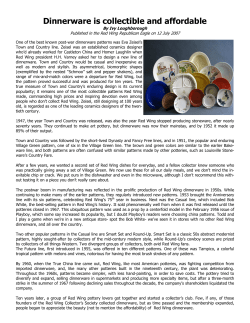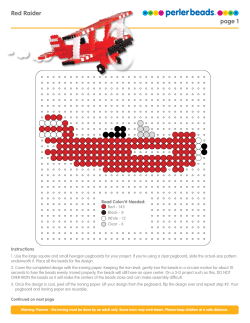
Light Aircraft manufacture and materials
Light Aircraft manufacture and materials Comparison of materials, specific buckling stiffness. Comparison of materials for specific stiffness (E/ro) column buckling ( E/ro^2) and panel buckling ( E/ro^3) 250 150 100 E/ro^2 E/ro^3 E/ro 50 Titanium alloy 7075 alloy 6082 alloy Steel 8.8 Fir Spruce Balsa Birch ply Epoxy matrix UDCFRP WCFRP UDGFRP 0 WGFRP E MPA /g/cc 200 E/ro E/ro^2 S F te ir e 60 l 8 . 82 8 70 allo Ti 75 y ta ni allo um y al lo y W G F U RP D G F W RP C F U RP E DC po F xy RP m a B trix irc h pl y B al s S a pr uc e specific strength MPa/g/cc Specific strength of materials UTS/ro 500 450 400 350 300 250 UTS/ro 200 150 100 50 0 St Fir ee 60 l 8 82 .8 70 allo Ti 75 y ta ni allo um y al lo y W G F UD R P G FR W P C F UD RP Ep C ox FR P y m a Bi trix rc h pl y Ba ls Sp a ru ce £/kg Relative cost of materials cost/kg 80 70 60 50 40 cost/kg 30 20 10 0 Considerations ● Metals – design for fatigue, corrosion ● Isotropic - best for 3D loads ● Bolted and rivetted joints good in metals ● Wood – drainage/ventilation, considerations apply as for composites ● Composites – Impact, drainage ( esp. foam),service temperature, repair schemes ● Wood and composite Orthotropic – best for 1D or 2D loads ● Rivetted joints unsuitable for thin composite or wood panels ● Fibres must be aligned with primary load paths ● Through-thickness peel and shear loads must be carefully considered ● Slot together joint features best – avoid peel loaded joints ● ● Carbon composite strain limit around 0.4% to allow for joints, repairs and to avoid damage growth after impact Special factors applicable for temperature degradation and variability of production ( see CS-VLA AMC 619) Design process ● Sketch ideas for layout, calculate flight envelope, weights, loads ● Simple hand or XL spreadsheet calculations ● Optimise layups using laminate analysis program to obtain A,B,D stiffness matrices ● Refine calculations and weight estimates ● Apply laminate analysis to FE program e.g. Nastran ● Check answers are in line with initial hand calcs ● Optimise FE design ● Build it and load test unless experienced with very similar previous analysis models CFM Shadow uses many different materials to good effect ● ● Fibrelam fuselage structure Extruded light alloy boom ● Foam ribs ● Ply leading edges ● Extruded spar caps ● Pultruded U/C legs Classic Cessna 150 light alloy semi-monocoque. Wing has few ribs and uses stiffeners, postbuckling at ultimate load. Poor payload/empty weight compared to Jodel. ARV super 2 – all light alloy, with super plastic formed fuselage belly pan. Now called Opus in USA with Rotax 912 engine. The Jodel with wood construction is light and efficient Columbin MC30 Luciole – even lighter! Columbin Luciole uses wood, foam and carbon pultrusions. ● ● ● ● ● 97kg empty, 200kg max 25bhp Briggs and Stratton V twin 100kt on 5 litres/hr Wing uses wood spar with carbon pultruded spar caps and foam ribs Wing is quickly detachable from fuselage Spar construction Wing skin bonding under partial vacuum Ply skinned wood fuselage Fuselage with wing connection Spar to fuselage carry-through structure V twin Briggs and Stratton conversion, direct drive The Mosquito used innovative design with wood to achieve excellent performance, pioneering modern composites design practice Mosquito construction ● ● ● ● ply/balsa/ply fuselage sandwich monocoque, with reinforcements built into the core Fuselage 80% fitted out in 2 halves, hydraulics in one side, electrics in the other ply/spruce stiffeners/ply wing skin sandwich panel production Laminated spruce spar caps with plywood shear webs Composites allow smooth aerodynamic shapes and laminar flow Glass/Epoxy UD fibres make an effective spring undercarriage The A.I.R. Atos has a cantilever carbon leading edge D box with folding ribs for transport, flaps for takeoff/landing, 15m span, 40kg, 20:1 glide and 150fpm sink rate Firewall uses reflective and intumescent coatings e.g. Technifire Storch uses mixed construction with extruded light alloy tailboom, strutted wing can be folded Prepreg/autoclave – high cost/high performance process with some problems. ● De-bulking required every 4 plies ● High energy usage ● Thermal stresses/warping ● Expensive equipment ● Traditional high-end aerospace process Vacuum bag processes ● ● ● ● Wet-preg/vac bag process gives better properties than bucket and brush Widely used for gliders, motorgliders, microlights Messy process Resin infusion process setup and process control more complex ● Clean process ● Low void content Stabilator sandwich skin vacuum bagged RFI and RTM ● ● ● ● ● ● ● RFI similar to resin infusion but allows toughened resins Easier to get uniform infusion over an area Vacuum stack compacts during cure RTM requires precision closed tools Good for small parts e.g. Propeller blades Process control and preform production critical Good finish with tight tolerances on all surfaces Winding, Wrapping and pultruding ● ● Filament winding or prepreg tape wrapping for torque tubes and pressure vessels Pultrusion and pulwinding give high quality constant section parts at low process cost Finishing composites ● ● ● ● ● Polyester gel coats favoured over epoxy for UV resistance – but check compatibility with epoxy gelcoat Brushed gel coats typically 1mm thick Spray gel coat 0.5mm thick, more uniform colour dispersion and metallic effects possible, air fed mask and fume extraction required Structural composites generally white to minimise surface temperature ( 54C) Lightest finish is to prime/surface then 2K acrylic paint – but very labour intensive CT production • CT rear fuselage is monocoque sandwich • Aramid used on inside skin • Reinforcing bulkheads carbon with ply inserts • Finish is by primer/filler then sanding and painting Slotted H-joint features in the Beech Starship Wing construction in a mould Mouldless methods Mouldless methods - shells Foldaplane concept for 2D curvatures Now for something completely different Which does different things QuikR – a 3D sports motorcycle ● Tailless flexwing configuration gives low empty weight and low parts count ● Empty 220kg, loaded 450kg ● 50-100 mph hands off, electric trim ● Lateral trim by nosewheel steering ● Range 400 miles at 80mph ● 38mph stall, 120mph Vne ● 1200fpm climb at max AUW on Rotax 912s ● Quick fold topless wing ● Seamless mandrel drawn 6082-T6 17swg tube airframe ● Extruded 6082 aerofoil struts ● Polyester mouldings with spray gel coat ● Extruded trike basetube and main pylon Fittings etc designed and optimised on CATIA/ABAQUS Sail reinforcing aramid bands and washout rods, composite tip fins, short aerofoil struts, pullwound carbon battens QuikR sail production ● ● ● ● 18 hours precision sailmaking, +- 1mm all over Advanced technology sail materials include Polyant HTP square sail main body, PX10T leading edge, X05 aramid unidirectional reinforcement bands, Mylar .040” leading edge stiffener with APS system. In flight strain gauging carried out with extensometer Sails produced on mylar templates with raised tape edges, shape is transferred with a 4h pencil ● Sail is assembled with seamstick double sided tape ● Simple automatic tape folder/adhesive applicator for making batten pockets ● Sewn together with Tenara spun PTFE UV proof thread ● Continued airworthiness testing by Bettsometer ( needle with calibrated spring balance) Sail loft with batten tape folder, raised tables and mylar template with thick tape profiles The last word on the subject! Scrapheap biplane build and flown in 3 days with 4 people Sailmaking for BAE Cayley glider Pilcher triplane replica Booster carbon fibre auxiliary power unit with folding propeller and retractable undercarriage
© Copyright 2025





















